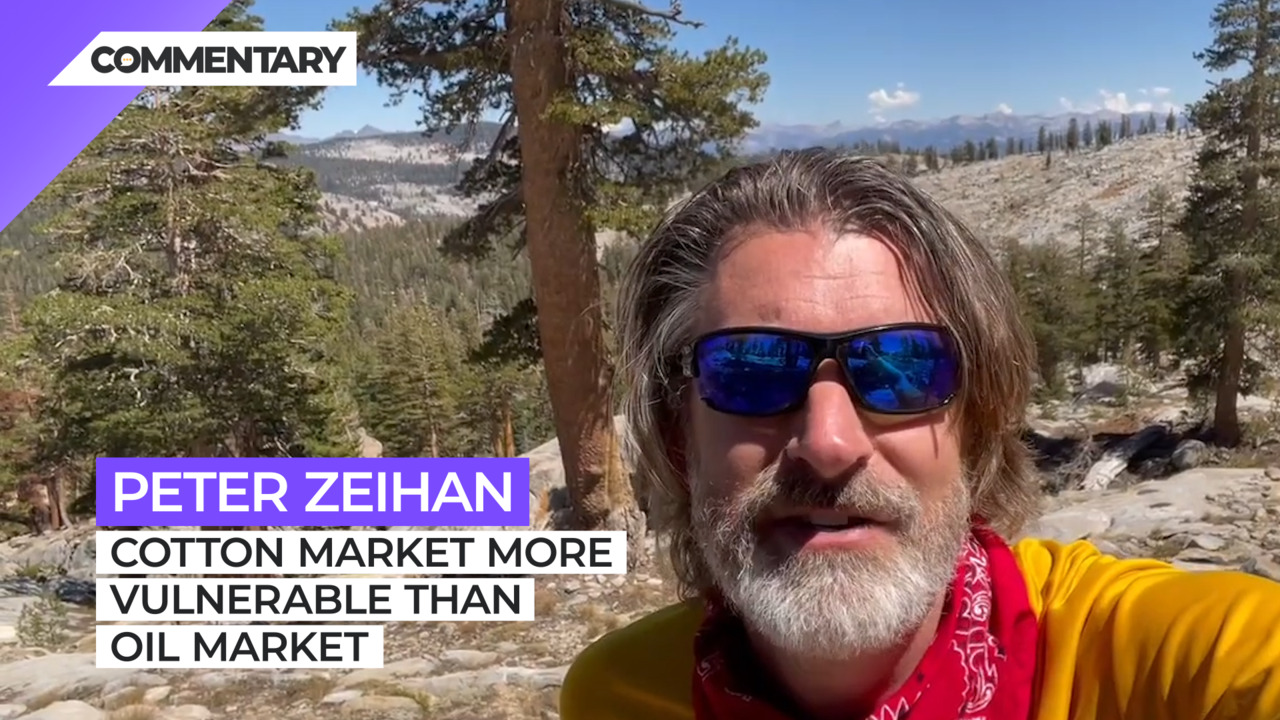
Commentary
-
Our commentary partners will help you reach your own conclusions on complex topics.
Hi, everyone, Peter Zion here coming to you from above Fernandez lake in the Sierra National Forest. Today is day three of the will Peter return a live tour. Obviously, we’ve had a significant improvement of the weather is barely a cloud in the sky, nice sunny light breeze. This is why a backpack. Anyway, since I dressed like a Bandito. Today, I thought today would be a good time to talk about cotton. Now cotton is odd. And that requires just a massive amount of water and a just relentless level of sunlight. And there just aren’t that many places on the planet that habit really there’s only about five Shang in China, Central Asia, specifically Uzbekistan, and Turkmenistan, the American South pacifically the Carolinas and Mississippi, Brazil and the Nile Valley. Now, it’s not that cotton is necessarily difficult to grow if you’ve got those right inputs. However, having it scattered to just five places, in many ways makes the cotton market actually more vulnerable to disruption than, say, the oil market. I mean, sure, you’re not going to see those wild price swings that we can see with oil because of inelastic demand. But it’s definitely a problem. And in the world that we are degrading into a lot of this stuff is simply going to fall off the market. So even assuming no one in the West develops a moral backbone on things like genocide, and Jiang, China is going to fall off a market over the course of the next decade, Brazil is probably going to be mostly stable, there’ll be an issue of trade links and government coherence, they’ll probably be able to hold it on the American South, obviously, we’ll be fine. Egypt, anything happens to global agriculture. And Egypt, cotton goes away completely. What the Egyptians had been doing for the last century, is selling cotton on international markets and using the income from that to buy wheat that then they subsidize in terms of selling it to their population. While the population under this policy has now expanded beyond the ability of Egypt to feed its own population have they switched everything to wheat. So if there’s a disruption to wheat supplies, not only do we get famine in Egypt, in order to prevent just mass carnage, the Egyptian Government will have no choice but to stop all cotton production and go back to wheat full time. That just leaves Central Asia. Now even before talk about climate change was in vogue around the world. We had an in progress, environmental disaster in Central Asia. There are two rivers this year in the dirt, the AMO and the seer, which the Soviets diverted to massive cotton plantations in the middle of the Central Asian deserts. That grew a lot of cotton, they were doing this so they wouldn’t have to tap in international markets to get say, Egyptian or southern cotton. But it meant that it took two rivers that drew water from a very limited glacial impact, and put it all in the desert. Well, 50 years later, 60 years later, the glaciers that provide that water are almost gone, they will disappear this decade, and then both of those rivers will disappear, and they will take the cotton with them. So we’re looking at roughly half maybe closer to two thirds of global cotton just going away this decade. It’s not all bad news. If you are in the American South, we now have technology that allows us to take cotton, clean it, color it, turn it into a thread, weave it into yarn, weave it into cloth and punch it into whatever shape we want, say T shirts, without a person touching it. You can now have a facility that’s about two acres with a staff of two software engineers that can produce more at a lower price point than 250 Bangladeshi Weaver’s. So the technology really has evolved quite a bit over the course of the last 15 years, and it’s going to lead to a very different market, one in which the American South will rise again. Okay, that’s it from me. Until next time, take care
-
Hurricane Helene hits US coast, Appalachia and beyond
Hurricane Helene hit Florida and Georgia overnight between Sept. 26 and 27 as a Category 4 hurricane, and accompanying storms will continue reaching deeper into the continental United States today. Dangerous flash flooding from the hurricane, known as storm surge, was some of the worst flooding that the Tampa Bay area has ever seen, and… -
Israel holds upper hand against Lebanon, Hezbollah and Iran
On Wednesday, Sept. 25, Hezbollah launched a ballistic missile at Tel Aviv in retaliation for Israel’s explosive pager attack that blew up devices across Lebanon. Although Israel’s defense systems intercepted the surface-to-surface missile, the attempted strike on Tel Aviv marked a significant escalation by Hezbollah. Since the siege on Gaza began, shortly after the Oct. 7, 2023,… -
The Sinaloa Cartel civil war
Fears of a civil war within the Sinaloa Cartel are growing as violence between competing factions within the cartel continues. The Mexican Army has dispatched around 600 elite troops to Sinaloa to help quell those fears, in addition to roughly 2,200 regular soldiers and National Guard. Watch the above video as Straight Arrow News contributor… -
New Ukrainian weapons hit Russia where it hurts
Ukrainian drones struck a major Russian ammunition depot, triggering a massive explosion that was captured on camera. According to the Ukrainian military, 2,000 tons of munitions had arrived at the depot before the attack. Over the past two years, Ukraine has significantly increased its domestic drone production, allowing it to scale up attacks on military… -
Weighing social costs vs. economic benefits on immigration
Global human migration is one of the defining elements of our current historical era, according to the United Nations. Migrants face both the incentives to leave — forced out by climate change, crime and corruption, extreme poverty or violence — and incentives for where to go, based on available job opportunities and so on. Migration…
Latest Stories
-
 Getty Images
Getty Images
Gene Hackman’s dead dog misidentified as details continue unfolding
-
 Getty Images
Getty Images
Sexual violence used as war tactic against Sudanese children: UNICEF
-
 Getty Images
Getty Images
Trump praises BlackRock for $19 billion Panama Canal investment
-
 Getty Images
Getty Images
President Trump announces arrest of Kabul airport bombing suspect
-
 Getty Images
Getty Images
Supreme Court requires Trump admin to pay $2B in frozen foreign aid
Popular Opinions
-
In addition to the facts, we believe it’s vital to hear perspectives from all sides of the political spectrum.
Latest Opinions
In addition to the facts, we believe it’s vital to hear perspectives from all sides of the political spectrum. We hope these different voices will help you reach your own conclusions.
The opinions published in this section are solely those of the contributors and do not reflect the views of Straight Arrow News.





















Latest Commentary
We know it is important to hear from a diverse range of observers on the complex topics we face and believe our commentary partners will help you reach your own conclusions.
The commentaries published in this section are solely those of the contributors and do not reflect the views of Straight Arrow News.
Dr. Frank Luntz
Pollster and Political Analyst‘Biased’: What Americans think of ‘mainstream media’
‘Getting rid of them’: Americans discuss Trump and immigration
‘Woke’: Why some Biden 2020 voters backed Trump in 2024